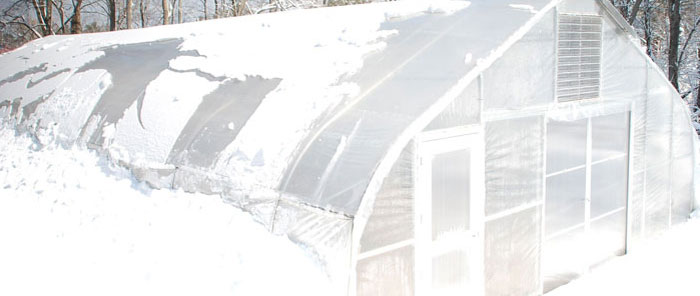Taking an environmentally sensitive approach to pest management
Snow Removal from High Tunnels
Published: February 16, 2021

Late winter snow or ice events can be very damaging to plant forcing structures such as high tunnels and greenhouses. Not too many years ago, a wet, heavy snow accompanied by high wind gusts caused considerable structure loss to Missouri vegetable growers. This article is written to provide some tips on how to avoid snow damage in future winter storms.
Avoiding damage from snow, sleet or ice begins with planning the high tunnel structure, and the architectural style selected can make a big difference. As a rule, Gothic arch styles are able to cope with heavy snowfall better than Quonset styles. First, the somewhat pointed ridge of the Gothic arch design helps to facilitate natural shedding of snow. Second, the weakest point of a Quonset unit is ridge, which is nearly horizontal. A Gothic arch (with its pointed ridge) distributes this weak point to the sides of its ribs which are more vertical in orientation, especially toward the edge of the unit.
Rib (bow) spacing also helps to determine a high tunnel's ability to withstand snow. Given the same pipe diameter, a high tunnel with four-foot rib spacing will be significantly stronger than one with six foot spacing. Closer rib spacing does add to initial construction cost but the extra strength (and peace of mind) might be well worth the cost in a heavy snow event.
Anchoring the ribs of a high tunnel properly during construction also helps strengthen it. In areas of high snow load or wind, anchoring every second rib in a concrete caisson is advisable. The caisson should be at least 24 inches in depth to prevent "frost heaving." Additionally, equipping the ribs of a high tunnel with cross members to form an A truss, greatly increases its strength. This can be accomplished by securely attaching a metal pipe inside of the high tunnel from one side of the rib to its other, above head height or about eight feet from the ground.
Given a high tunnel of questionable strength is already in place and a heavy snow is predicted there are measures that can be taken to protect it. A rope thrown over the top of the structure and "walked" back and forth by workers holding the rope on either side can help to remove snow, especially from the high tunnel's ridge area. Snow that builds up on the sides of the ribs can be manually scraped off with a rake or scrapper with an extra long handle attached. Make sure that a material that will not damage plastic is attached to the bottom of the scraper. Also, a wooden pole or three-inch PVC pipe with several layers of carpet affixed to the end can be used to push or "poke" the plastic from the inside of the unit. The flexing of the plastic that occurs from this procedure causes snow that has built up to slide off, in many cases.
Finally, adding internal support in the form of temporary purlin posts extending from the ground to the apex of every second or third rib can be very helpful in preventing snow damage. Wooden 2X4's make excellent supports and are relatively easy to install if two of them are pieced together. Make certain, however, the internal support sits on something with a fairly wide "footprint" (e.g. concrete block) so the weight of the snow does not push the end of the support into the soil.
If none of the above is able to keep up with snow accumulation, a difficult managerial decision needs to be made. Slitting the plastic from the inside to allow accumulated snow to fall through to the ground will ruin the plastic but save the metal ribs. While not inexpensive, plastic is considerably cheaper to replace than metal ribs.
Subscribe to receive similar articles sent directly to your inbox!
REVISED: February 16, 2021